Tango
Tango is a partner dance, and social dance that originated in the 1880s along the Río de la Plata, the natural border between Argentina and Uruguay. It was born in the impoverished port areas of these countries, with enslaved African populations.[2] The tango is the result of a combination of African Candombe, Spanish-Cuban Habanera, and Argentinian Milonga.[3] The tango was frequently practiced in the brothels and bars of ports, where business owners employed bands to entertain their patrons with music.[4] The tango then spread to the rest of the world.[5] Many variations of this dance currently exist around the world.
| Tango | |
|---|---|
A couple dances the Argentine tango | |
| Stylistic origins | |
| Cultural origins | 1850–1890, |
| Typical instruments | |
| Derivative forms |
|
| Subgenres | |
| |
| Fusion genres | |
| |
| Other topics | |
| Tango music | |
| This article is part of a series on the |
| Culture of Argentina |
|---|
 |
|
Arts & Literature |
|
Pastimes
|
|
Argentina portal |
On August 31, 2009, UNESCO approved a joint proposal by Argentina and Uruguay to include the tango in the UNESCO Intangible Cultural Heritage Lists.[6][7]
History
Tango is a dance that has influences from African, Native American and European culture.[8] Dances from the candombe ceremonies of former African slave peoples helped shape the modern day tango. The dance originated in lower-class districts of Buenos Aires and Montevideo. The music derived from the fusion of various forms of music from Europe.[9] The words "tango" and "tambo" around the River Plate basin were initially used to refer to musical gatherings of slaves, with written records of colonial authorities attempting to ban such gatherings as early as 1789.[10]
Initially, it was just one of the many dances, but it soon became popular throughout society, as theatres and street barrel organs spread it from the suburbs to the working-class slums, which were packed with hundreds of thousands of European immigrants.[11]
Culture Shock was very apparent when the tango hit the new world in the 1900s the way of life was very conservative, the tango was not considered a conservative dance by any means. The tango was seen as extremely sexual for the culture of 1900.[12] The tango also brought parts of cultures from Africa and also from Europe, both things that were new for the western world.[12]
Many Buenos Aires city neighbourhoods have their particular tango history like for example La Boca, San Telmo or Boedo. At Boedo Avenue Cátulo Castillo, Homero Manzi and other singers and composers used to meet at the Japanese Cafe with the Boedo Group.
In the early years of the 20th century, dancers and orchestras from Buenos Aires travelled to Europe, and the first European tango craze took place in Paris, soon followed by London, Berlin, and other capitals. Towards the end of 1913, it hit New York City in the U.S., and Finland. In the U.S., around 1911, the word "tango" was often applied to dances in a 2
4 or 4
4 rhythm such as the one-step. The term was fashionable and did not indicate that tango steps would be used in the dance, although they might be. Tango music was sometimes played but at a rather fast tempo. Instructors of the period would sometimes refer to this as a "North American tango", versus the so-called "Argentine Tango". The Tango was controversial because of its perceived sexual overtones and, by the end of 1913, the dance teachers who had introduced the dance to Paris were banished from the city.[13] By 1914, more authentic tango stylings were soon developed, along with some variations like Albert Newman's "Minuet" tango.
In Argentina, the onset in 1929 of the Great Depression, and restrictions introduced after the overthrow of the Hipólito Yrigoyen government in 1930, caused tango to decline. Its fortunes were reversed as tango became widely fashionable and a matter of national pride under the government of Juan Perón. Taquito Militar by Mariano Mores played a monumental part in the rise of the tango and a major effect on Argentinian culture as a whole. This song was premiered in 1952 during a governmental speech of President Juan D. Perón, which generated a strong political and cultural controversy between different views of the concepts of "cultured" music and "popular" music, as well as the links between both "cultures".
Tango declined again in the 1950s, as a result of economic depression and the banning of public gatherings by the military dictatorships; male-only tango practice—the custom at the time—was considered "public gathering". That, indirectly, boosted the popularity of rock and roll because, unlike tango, it did not require such gatherings.[14]
In 2009, the tango was added to the UNESCO Intangible Cultural Heritage Lists.[15]
Etymology
There are two predominant theories regarding the origin of the word "tango." The African culture is credited by some scholars as the creator of this word. It is theorized that the word evolved from the Yoruba word, "shangó," which refers to the Nigerian God of Thunder.[16] This theory suggests that the word “shangó” was morphed through the dilution of the Nigerian language once it reached South America via slave trade. This theory is paralleled by another theory which believes that “tango” is derived from the Spanish word for drum, “tambor."[16] This word was then mispronounced by Buenos Aires’ impoverished and uneducated inhabitants to become "tambo," then ultimately resulting in the common "tango." It is also theorized that the word "'tango" is derived from the Portuguese word "tanger," which means "to play a musical instrument." Another Portuguese word, "tangomão," is a possible predecessor of the word "tango." The word is the combination of the verb "tanger" (to touch) with the noun "mão" (hand), and resulted in the verb "to play a musical instrument with one's hands.2"[17]
Styles

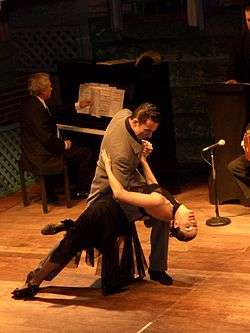
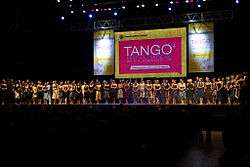
The tango consists of a variety of styles that developed in different regions and eras of Argentina as well as in other locations around the world. The dance developed in response to many cultural elements, such as the crowding of the venue and even the fashions in clothing. The styles are mostly danced in either open embrace, where lead and follow have space between their bodies, or close embrace, where the lead and follow connect either chest-to-chest (Argentine tango) or in the upper thigh, hip area (American and International tango).
Different styles of tango are:
- Tango argentino
- Tango canyengue
- Tango Oriental Uruguayan tango
- Tango liso
- Tango salon
- Tango orillero
- Tango camacupense (Angola)
- Tango milonguero (tango apilado) (see also "Milonguero")
- Tango nuevo (new tango)
- Tango vals
- Milonga
- Ballroom tango
- Finnish tango
These are danced to several types of music:
- Tango
- Electronic tango-inspired music
- "Alternative tango", i.e. music that is an alternative to tango, or non-tango music employed for use in tango-inspired dance
The milonguero style is characterized by a very close embrace, small steps, and syncopated rhythmic footwork. It is based on the petitero or caquero style of the crowded downtown clubs of the 1950s.
In contrast, the tango that originated in the family clubs of the suburban neighborhoods (Villa Urquiza/Devoto/Avellaneda etc.) emphasizes long elegant steps, and complex figures. In this case the embrace may be allowed to open briefly, to permit execution of the complex footwork.
The complex figures of this style became the basis for a theatrical performance style of tango seen in the touring stage shows. For stage purposes, the embrace is often open, and the complex footwork is augmented with gymnastic lifts, kicks, and drops.
A newer style sometimes called tango nuevo or "new tango", has been popularized in recent years by a younger generation of dancers. The embrace is often quite open and very elastic, permitting the leader to lead a large variety of very complex figures. This style is often associated with those who enjoy dancing to jazz- and techno-tinged "alternative tango" music, in addition to traditional tango compositions.
Tango de salon (salon tango)
Tango canyengue
Tango canyengue is a rhythmic style of tango that originated in the early 1900s and is still popular today. It is one of the original roots styles of tango and contains all fundamental elements of traditional Tango from the River Plate region (Uruguay and Argentina). In tango canyengue the dancers share one axis, dance in a closed embrace, and with the legs relaxed and slightly bent. Tango canyengue uses body dissociation for the leading, walking with firm ground contact, and a permanent combination of on- and off-beat rhythm. Its main characteristics are its musicality and playfulness. Its rhythm is described as "incisive, exciting, provocative".
The complex figures of this style became the basis for a theatrical performance style of Tango seen in the touring stage shows. For stage purposes, the embrace is often very open, and the complex footwork is augmented with gymnastic lifts, kicks, and drops.
Tango nuevo
A newer style sometimes called tango nuevo or "new tango" was popularized after 1980 by a younger generation of musicians and dancers. Ástor Piazzolla, composer and virtuoso of the bandoneón (so-called "tango accordion") played a major role in the innovation of traditional tango music. The embrace is often quite open and very elastic, permitting the leader to initiate a great variety of very complex figures. This style is often associated with those who enjoy dancing to jazz- and techno-tinged, electronic and alternative music inspired in old tangos, in addition to traditional Tango compositions.
Tango nuevo is largely fueled by a fusion between tango music and electronica (electrotango), though the style can be adapted to traditional tango and even non-tango songs. Gotan Project released its first tango fusion album in 2000, quickly following with La Revancha del Tango in 2001. Bajofondo Tango Club, a Rioplatense music band consisting of seven musicians from Argentina and Uruguay, released their first album in 2002. Tanghetto's album Emigrante (electrotango) appeared in 2003 and was nominated for a Latin Grammy in 2004. These and other electronic tango fusion songs bring an element of revitalization to the tango dance, serving to attract a younger group of dancers.
New tango songs
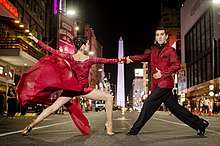
In the second half of the 1990s, a movement of new tango songs was born in Buenos Aires. It was mainly influenced by the old orchestra style rather than by Piazzolla's renewal and experiments with electronic music. The novelty lies in the new songs, with today's lyrics and language, which find inspiration in a wide variety of contemporary styles.
In the 2000s, the movement grew with prominent figures such as the Orquesta Típica Fernandez Fierro, whose creator, Julian Peralta,[18][19] would later start Astillero and the Orquesta Típica Julián Peralta. Other bands also have become part of the movement such as the Orquesta Rascacielos, Altertango, Ciudad Baigón, as well as singer and songwriters Alfredo "Tape" Rubín,[18] Victoria di Raimondo,[18] Juan Serén,[18] Natalí de Vicenzo[18] and Pacha González.[18]
Ballroom tango
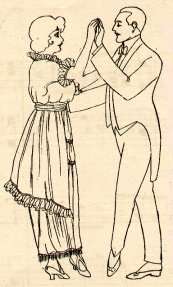
Ballroom tango, divided in recent decades into the "International" and "American" styles, has descended from the tango styles that developed when the tango first went abroad to Europe and North America. The dance was simplified, adapted to the preferences of conventional ballroom dancers, and incorporated into the repertoire used in International Ballroom dance competitions. English tango was first codified in October 1922, when it was proposed that it should only be danced to modern tunes, ideally at 30 bars per minute (i.e. 120 beats per minute – assuming a 4
4 measure).
Subsequently, the English tango evolved mainly as a highly competitive dance, while the American tango evolved as an unjudged social dance with an emphasis on leading and following skills. This has led to some principal distinctions in basic technique and style. Nevertheless, there are quite a few competitions held in the American style, and of course mutual borrowing of technique and dance patterns happens all the time.
Ballroom tangos use different music and styling from the tangos from the River Plata region (Uruguay and Argentina), with more staccato movements and the characteristic head snaps. The head snaps are totally foreign to Argentine and Uruguayan tango, and were introduced in 1934 under the influence of a similar movement in the legs and feet of the tango from the River Plate, and the theatrical movements of the pasodoble. This style became very popular in Germany and was soon introduced to England. The movements were very popular with spectators, but not with competition judges.[20]
Finnish tango

Tango arrived in Finland in 1913. The tango spread from the dominant urban dance form to become hugely popular across Finland in the 1950s after World War I and World War II. The melancholy tone of the music reflects the themes of Finnish folk poetry; Finnish tango is almost always in a minor key.
The tango is danced in very close full thigh, pelvis and upper body contact in a wide and strong frame, and features smooth horizontal movements that are very strong and determined. Dancers are very low, allowing long steps without any up and down movement, although rises and falls are optional in some styles. Forward steps land heel first except when descending from a rise, and in backward steps dancers push from the heel. In basic steps, the passing leg moves quickly to rest for a moment close to the grounded leg. Dips and rotations are typical. There is no open position, and typically feet stay close to the floor, except in dips the follower might slightly raise the left leg. Unlike in some Latin American tango styles, in Finnish tango there is no kicking of any kind, and there are no aerials.
The annual Finnish tango festival Tangomarkkinat draws over 100,000 tangophiles to the central Finnish town of Seinäjoki; the town also hosts the Tango Museum..
Comparison of techniques
Argentine, Uruguayan, and Ballroom Tango use very different techniques. In Argentine and Uruguayan tango, the body's center moves first, then the feet reach to support it. In ballroom tango, the body is initially set in motion across the floor through the flexing of the lower joints (hip, knee, ankle) while the feet are delayed, then the feet move quickly to catch the body, resulting in snatching or striking action that reflects the staccato nature of this style's preferred music.
In tango, the steps are typically more gliding, but can vary widely in timing, speed, and character, and follow no single specific rhythm. Because the dance is led and followed at the level of individual steps, these variations can occur from one step to the next. This allows the dancers to vary the dance from moment to moment to match the music (which often has both legato and/or staccato elements) and their mood.
The Tango's frame, called an abrazo or "embrace", is not rigid, but flexibly adjusts to different steps, and may vary from being quite close, to offset in a "V" frame, to open. The flexibility is as important as is all movement in dance. The American Ballroom Tango's frame is flexible too, but experienced dancers frequently dance in closed position: higher in the elbows, tone in the arms and constant connection through the body. When dancing socially with beginners, however, it may be better to use a more open position because the close position is too intimate for them. In American Tango open position may result in open breaks, pivots, and turns which are quite foreign in Argentine tango and International (English) tango.
There is a closed position as in other types of ballroom dance, but it differs significantly between types of tango. In Tango from the River Plata region, the "close embrace" involves continuous contact at the full upper body, but not the legs. In American Ballroom tango, the "close embrace" involves close contact in the pelvis or upper thighs, but not the upper body. Followers are instructed to thrust their hips forward, but pull their upper body away and shyly look over their left shoulder when they are led into a "corte".
In tango from the River Plate region, the open position, the legs may be intertwined and hooked together, in the style of Pulpo (the Octopus). In Pulpo's style, these hooks are not sharp, but smooth ganchos.
In Tango from the River Plata, Uruguay and Argentina, the ball or toe of the foot may be placed first. Alternatively, the dancer may take the floor with the entire foot in a cat-like manner. In the International style of Tango, "heel leads" (stepping first onto the heel, then the whole foot) are used for forward steps.
Ballroom tango steps stay close to the floor, while the River Plata Tango (Uruguayan and Argentine) includes moves such as the boleo (allowing momentum to carry one's leg into the air) and gancho (hooking one's leg around one's partner's leg or body) in which the feet travel off the ground. Both Uruguayan and Argentine tango features other vocabulary foreign to ballroom, such as the parada (in which the leader puts his foot against the follower's foot), the arrastre (in which the leader appears to drag or be dragged by the follower's foot), and several kinds of sacada (in which the leader displaces the follower's leg by stepping into her space).
Famous tango singers
- Carlos Acuña[TT] [t.i] (1915–1999) was known for his deep, high and expressive voice. His foreign travels brought him success in Uruguay, Mexico, Italy and Spain, where he became a close friend of the exiled Juan Perón.[21]
- Néstor Fabián[TT]
- Carlos Gardel[t.i]
- Roberto Goyeneche[TT] [t.i]
- Julio Sosa[TT] [t.i] (1926–1964) from Uruguay was one of the most important tango singers during tango's unhappy years in the 1950s and early 1960s. His passion for poetry led to his sole published book; his passion for fast cars led to his young death.[22]
- Olavi Virta
- Reijo Taipale
- Tita Merello[TT]
- Edmundo Rivero[TT]
- Pyotr Leschenko
Tango influence
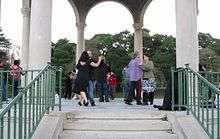
Music and dance elements of tango are popular in activities related to gymnastics, figure skating, synchronized swimming, etc., because of its dramatic feeling and its cultural associations with romance.
For the 1978 FIFA World Cup in Argentina, Adidas designed a ball and named it Tango, likely a tribute to the host country of the event.[23] This design was also used in 1982 FIFA World Cup in Spain as Tango Málaga,[24] and in 1984 and 1988 UEFA European Football Championships in France and West Germany.
Tango in society
Tango appears in different aspects of society: Regular milongas and special festivals. A very famous festival is the Tango Buenos Aires Festival y Mundial in Buenos Aires also known as World tango dance tournament. On a regional level there are also many festivals inside and outside of Argentina. One local festival outside Argentina is Buenos Aires in the Southern Highlands in Australia.
Gender and Tango
Typically the tango is performed between a man and a woman, however the two have very different aspirations within the tango. Woman often looked to the tango to help them gain confidence and to help them find a potential relationship.[25] Men however looked to the tango for intimate reasons, and were known to be flirty and sexually willing.[25] Women, however, were primarily focused on the dance itself and became wealthy.[25] As time went on and the tango culture changed, women and men often wanted to travel and compete and also teach tango classes and then both women and men are viewed as equals.[25]
Gender roles also plays a big part in the mechanics of tango due to the tango needing a leader. But in more recent times this is being challenged due to woman not wanting to be dependent on the male for the dance.[26] In the early 1900s, there were often more male dancers than female so the dance was performed between two men. This allowed for both men to learn the leading and following roles of tango and adapt to both lead equally in the dance. This changed the mechanics of the dance to be closer to two equally leading roles between men and women or same sex pairs.[27]
Health benefits
It has been suggested that tango makes people feel more relaxed, sexier, and less depressed, and increases testosterone levels.[28]
Dance targets six main areas considered to be important for high quality of life and successful aging:
- physical exercise
- social satisfaction
- spirituality and mindfulness
- cognition
- meaningfulness
- emotional and educational health
While all types of dance confers some types of benefits, Argentine tango dancing, in particular, has documented evidence that these areas are improved in both healthy and disabled populations.[29]
Tangolates is an exercise method that combines the core stability of Pilates with the concentration, coordination and fluid movement of tango, designed in 2004 by Tamara Di Tella. Utilizing a partner-method and incorporating the aerobic or cardio element of music, it started as a rehabilitation technique for patients with severe dysfunctions of the nervous system.
Tango in film
Argentine tango is the main subject in these films:
- ¡Tango! (1933)
- Kaatru Veliyidai (2017) directed by Mani Ratnam with the song Tango Kelayo composed by Oscar winner A.R. Rahman and lyrics written by 5 national award winner vairamuthu.
- Adiós Buenos Aires (1938)
- Tango: El Exilio de Gardel/Tangos: the Exile of Gardel (1985), starring Philippe Léotard, directed by Fernando Solanas
- Tango Bar[30] (1988), starring Raúl Juliá
- The Tango Lesson (1997), starring Sally Potter and Pablo Verón, directed by Sally Potter
- Tango (1998), starring Cecilia Narova and Mía Maestro, directed by Carlos Saura
- Assassination Tango (2002), starring Robert Duvall, Rubén Blades and Kathy Baker, directed by Robert Duvall
- Orquesta Típica (2005), documentary film about typical orchestra Fernandez Fierro, directed by Nicolas Entel
- 12 Tangos – Adios Buenos Aires (2005), directed by Arne Birkenstock
- Tango libre (2012), directed by Frédéric Fonteyne
- Vaje v objemu / Practice in embrace (2012), directed by Metod Pevec
A number of films show tango in several scenes, such as:
- The Threepenny Opera (Die 3-Groschen-Oper) (1931), directed by G. W. Pabst, has number called Tango Ballade.
- The Plow That Broke the Plains (1936), directed by Pare Lorentz.
- The Four Horsemen of the Apocalypse (1921), starring Rudolph Valentino and Alice Terry, directed by Rex Ingram.
- L'amore in città (1953), segment "Paradise for three hours" (Paradiso per tre ore), directed by Dino Risi, starring nonprofessional actors, featuring a long sequence in a ballroom, where a passionate tango of Mario Nascimbene is played.
- Il Conformista (1970), starring Jean-Louis Trintignant and Dominique Sanda, directed by Bernardo Bertolucci.
- Last Tango in Paris (1972), starring Marlon Brando and Maria Schneider, directed by Bernardo Bertolucci.
- The World's Greatest Lover (1977), starring Gene Wilder (who also directed), Carol Kane and Dom DeLuise.
- Death on the Nile (1978), Peter Ustinov and Olivia Hussey tango whilst David Niven is the unfortunate partner to Angela Lansbury's rather eccentric version of the dance.
- Tango (1981), a short animation film by Zbigniew Rybczynski. Received an Oscar for Best Animated Short Film, Academy Awards 1982.
- Never Say Never Again (1983), starring Sean Connery and Kim Basinger, directed by Irvin Kershner.
- Naked Tango (1990), starring Vincent D'Onofrio and Mathilda May, directed by Leonard Schrader.
- Scent of a Woman (1992), Al Pacino as blind Colonel dances Argentine Tango.
- Strictly Ballroom (1992), directed by Baz Luhrmann.
- Addams Family Values (1993), Raul Julia and Anjelica Huston dance a tango so passionate that it literally burns the floor and makes all the champagne bottles in the nightclub pop their corks.
- Schindler's List (1993), starring Liam Neeson.
- True Lies (1994), starring Arnold Schwarzenegger, Jamie Lee Curtis and Tia Carrere, directed by James Cameron.
- Evita (1996), Madonna and Antonio Banderas dance a ballroom tango.
- Happy Together (1997), directed by Wong Kar-wai.
- Moulin Rouge! (2001), featuring Ewan McGregor and "El Tango de Roxanne".
- Waking Life (2001), directed by Richard Linklater.
- Le Tango Des Rashevski (2002).
- Chicago (2002), starring Renée Zellweger, Catherine Zeta-Jones, and Richard Gere, directed by Rob Marshall includes a song titled "The Cell Block Tango" and is accompanied with a dance.
- Frida (2002), Salma Hayek and Ashley Judd dance a tango to the Lila Downs performed song "Alcoba Azul".
- Shall We Dance (2004), starring Richard Gere, Jennifer Lopez and Susan Sarandon, directed by Peter Chelsom.
- Madonna featured choreography inspired by the Argentine tango styles for the Die Another Day section of her 2004 Re-Invention Tour. Segments of the 2005 documentary I'm Going To Tell You A Secret show this choreography in use.
- Rent (2005) had Anthony Rapp and Tracie Thoms perform a semi-elaborate ballroom tango in the song "Tango:Maureen" to describe their emotional relations and issues over a promiscuous girl they both dated.
- Mad Hot Ballroom (2005), documentary directed by Marilyn Agrelo.
- Love and Other Disasters (2006): Jacks (Brittany Murphy) and Paolo (Santiago Cabrera) perform a tango together.
- Take the Lead (2006), starring Antonio Banderas, directed by Liz Friedlander.
- Another Cinderella Story (2008), starring Selena Gomez and Drew Seeley. Performed during the Black and White Ball in the scene where Mary drops her Zune.
- Easy Virtue (2008), in which Jessica Biel and Colin Firth dance a tango.
- Step Up 3D (2010), in which Rick Malambri, Sharni Vinson and some of the supporting characters at a ballroom, dance a tango to Jazmine Sullivan's Bust Your Windows.
- Pixilation II (2011), short animation film by Kambras.
Finnish tango is featured to a greater or lesser extent in the following films:
- Onnen maa (1993), starring Pertti Koivula and Katariina Kaitue, directed by Markku Pölönen.
- Levottomat (2000), starring Mikko Nousiainen and Laura Malmivaara, directed by Aku Louhimies.
- Tulitikkutehtaan tyttö (1990), starring Kati Outinen, directed by Aki Kaurismäki.
- Mies vailla menneisyyttä (2002), starring Markku Peltola and Kati Outinen, directed by Aki Kaurismäki.
- Varjoja paratiisissa (1986), starring Matti Pellonpää and Kati Outinen, directed by Aki Kaurismäki.
- Kuutamolla (2002), starring Minna Haapkylä and Laura Malmivaara, directed by Aku Louhimies.
- Tango Kabaree (2001), starring Martti Suosalo and Aira Samulin, directed by Pekka Lehto.
- Minä soitan sinulle illalla (1954), starring Olavi Virta, directed by Armand Lohikoski.
Gallery


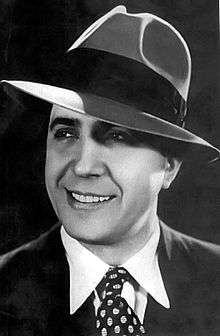 Carlos Gardel.
Carlos Gardel.
.jpg)
References
- Blatter, Alfred (2007). Revisiting music theory: a guide to the practice, p.28. ISBN 0-415-97440-2.
- University of Michigan. "Tango". Musica Del Mundo Hispano.
- Chasteen, John Charles (2004). National Rhythms, African Roots: The Deep History of Latin American Popular Dance. University of New Mexico Press.
- Castro, Donald (January 1990). "The Soul of the People: The Tango as a Source for Argentine Social History". Studies in Latin American Popular Culture. 9: 279.
- Termine, Laura (September 30, 2009). "Argentina, Uruguay bury hatchet to snatch tango honor". Buenos Aires. Retrieved April 2, 2010.
- "Culture:The Tango". UNESCO Archives Multimedia website. UNESCO. Retrieved 30 November 2010.
- "The Tango". Intangible Heritage Lists. UNESCO. Retrieved 30 November 2010.
- Miller, Marilyn Grace (2004). Rise and Fall of the Cosmic Race. University of Texas Press. pp. 82–89. ISBN 0-292-70572-7. Retrieved 2009-03-22.
- "Couple Dancing and the Beginning of Tango". www.history-of-tango.com. Retrieved 2018-04-25.
- Giménez, Gustavo Javier (30 September 2010). "Expresiones músico-religiosas como mecanismos de legitimación cultural. El caso de la comunidad africana en Buenos Aires entre 1776-1852" (PDF) (in Spanish). Instituto Ravignani, Facultad de Filosofía y Letras, UBA. p. 5. Retrieved 21 April 2016.
- Frommers. Destinations. Buenos Aires
- "Culture Shock: Flashpoints: Music and Dance: The Tango". www.pbs.org. Retrieved 2020-03-24.
- Knowles, Mark. The Wicked Waltz and Other Scandalous Dances
- Denniston, Christine. "The History of Tango Dance". Retrieved 7 May 2012.
- "UN declares tango part of world cultural heritage". Sydney Morning Herald. Sep 30, 2009. Retrieved Sep 30, 2009.
- Poosson, Sylvain (Fall 2004). ""Entre Tango y Payada: The Expression of Blacks in 19th Century Argentina."". Confluencia. 20: 87–99.
- Megenney, William W. (2003). "The River Plate "Tango": Etymology and Origins". Afro-Hispanic Review. 22 (2): 39–45. JSTOR 23054732.
- "Tangos de estreno: clásicos de las orquestas del futuro". Retrieved 2016-10-09.
- Cas, Andrés. "Levantar al tango de su siesta". Clarin.com. Retrieved 2016-10-09.
- PJS Richardson, History of English Ballroom Dancing, Herbert Jenkins 1946, pp. 101–102
- Jorge Palacio, Carlos Acuña, todotango.com. URL accessed 12 July 2006
- Roberto Selles. Julio Sosa. todotango.com. URL accessed 12 July 2006
- "Tango 1978". www.soccerballworld.com.
- "Tango 1982". www.soccerballworld.com.
- Törnqvist, Maria (2012-10-17). "troubling romance tourism: sex, gender and class inside the Argentinean tango clubs". Feminist Review. 102 (1): 21–40. doi:10.1057/fr.2012.12. ISSN 0141-7789.
- "Dancing Tango" (PDF).
- ricciotti, chris (2011). "Welcome to Gender Free Dancing". Historical Perspective.
- "Mind Your Body: Dance Yourself Happy". Psychology Today. Retrieved 24 February 2016.
- "The benefits of Argentine tango dancing". Retrieved 9 August 2016.
- "Tango Bar". 1 April 1988 – via www.imdb.com.
Further reading
- Davis, Kathy (2015). Dancing Tango: passionate encounters in a globalising world'. NYUP.
- Kassabova, Kapka (2011). Twelve Minutes of Love, a tango story (English), Portobello.ISBN 1846272858, 9781846272851
- Leymarie, Isabelle (1996). Du tango au reggae: musiques noires d’Amérique latine et des Caraïbes. Paris: Flammarion. ISBN 2082108139.
- Leymarie, Isabelle (1997). La música latinoaméricana: Ritmos y danzas de un continente. Barcelona: BSA. ISBN 8440677057.
- Nau, Nicole (1999). Tango Dimensionen (German), Kastell Verlag GmbH, ISBN 978-3-924592-65-3.
- Nau, Nicole (2000). Tango, un baile bien porteño (Spanish), Editorial Corregidor, ISBN 950-05-1311-0
- Park, Chan (2005). Tango Zen: Walking Dance Meditation (English), Tango Zen House, ISBN 0-9759630-0-7
- Park, Chan (2008). TangoZen: Caminar y Meditar Bailando (Spanish-English), Editorial Kier, ISBN 978-950-17-1032-8
- Savigliano, Marta E. (1995) Tango and the Political Economy of Passion. Westview Press, ISBN 978-0813316383
- Turner, David (2006). A Passion for Tango (English), Dingley Press 2004 Revised and augmented, ISBN 978-0-954-70831-3
External links
| Wikimedia Commons has media related to Tango (music). |